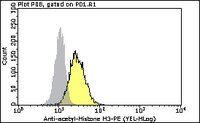HIV-1 expression within resting CD4+ T cells after multiple doses of vorinostat.
Archin, NM; Bateson, R; Tripathy, MK; Crooks, AM; Yang, KH; Dahl, NP; Kearney, MF; Anderson, EM; Coffin, JM; Strain, MC; Richman, DD; Robertson, KR; Kashuba, AD; Bosch, RJ; Hazuda, DJ; Kuruc, JD; Eron, JJ; Margolis, DM
The Journal of infectious diseases
210
728-35
2014
Show Abstract
A single dose of the histone deacetylase inhibitor vorinostat (VOR) up-regulates HIV RNA expression within resting CD4(+) T cells of treated, aviremic human immunodeficiency virus (HIV)-positive participants. The ability of multiple exposures to VOR to repeatedly disrupt latency has not been directly measured, to our knowledge.Five participants in whom resting CD4(+) T-cell-associated HIV RNA (rc-RNA) increased after a single dose of VOR agreed to receive daily VOR Monday through Wednesday for 8 weekly cycles. VOR serum levels, peripheral blood mononuclear cell histone acetylation, plasma HIV RNA single-copy assays, rc-RNA, total cellular HIV DNA, and quantitative viral outgrowth assays from resting CD4(+) T cells were assayed.VOR was well tolerated, with exposures within expected parameters. However, rc-RNA measured after dose 11 (second dose of cycle 4) or dose 22 (second dose of cycle 8) increased significantly in only 3 of the 5 participants, and the magnitude of the rc-RNA increase was much reduced compared with that after a single dose. Changes in histone acetylation were blunted. Results of quantitative viral outgrowth and other assays were unchanged.Although HIV latency is disrupted by an initial VOR dose, the effect of subsequent doses in this protocol was much reduced. We hypothesize that the global effect of VOR results in a refractory period of ≥ 24 hours. The optimal schedule for VOR administration is still to be defined. | | | 24620025
 |
Total levels of hippocampal histone acetylation predict normal variability in mouse behavior.
Nesbitt, AM; McCurdy, RD; Bryant, SM; Alter, MD
PloS one
9
e94224
2014
Show Abstract
Genetic, pharmacological, and environmental interventions that alter total levels of histone acetylation in specific brain regions can modulate behaviors and treatment responses. Efforts have been made to identify specific genes that are affected by alterations in total histone acetylation and to propose that such gene specific modulation could explain the effects of total histone acetylation levels on behavior - the implication being that under naturalistic conditions variability in histone acetylation occurs primarily around the promoters of specific genes.Here we challenge this hypothesis by demonstrating with a novel flow cytometry based technique that normal variability in open field exploration, a hippocampus-related behavior, was associated with total levels of histone acetylation in the hippocampus but not in other brain regions.Results suggest that modulation of total levels of histone acetylation may play a role in regulating biological processes. We speculate in the discussion that endogenous regulation of total levels of histone acetylation may be a mechanism through which organisms regulate cellular plasticity. Flow cytometry provides a useful approach to measure total levels of histone acetylation at the single cell level. Relating such information to behavioral measures and treatment responses could inform drug delivery strategies to target histone deacetylase inhibitors and other chromatin modulators to places where they may be of benefit while avoiding areas where correction is not needed and could be harmful. | Fluorescence Activated Cell Sorting (FACS) | Mouse | 24788142
 |










